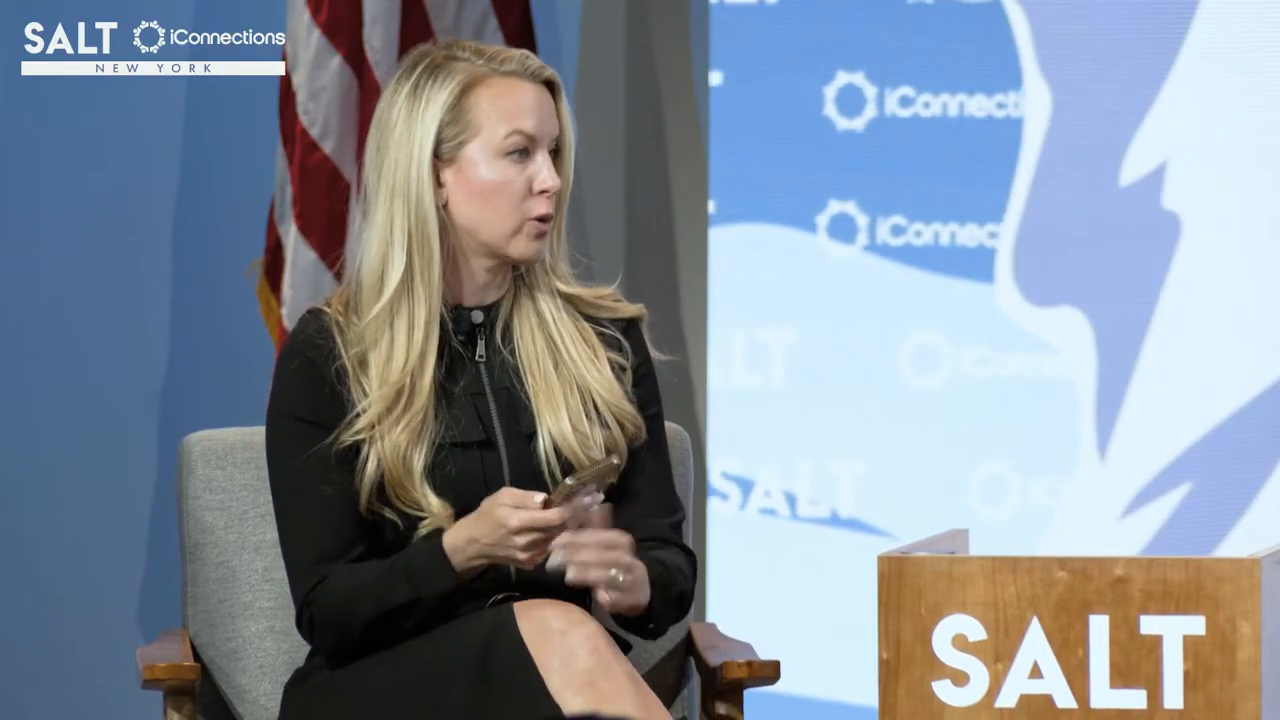Executive Summary
The panel discussion opens with a warm welcome and the intriguing theme of how the participants ventured into the world of cryptocurrency. The conversation kicks off with June, the co-founder and president of Figur Technologies, who shares insights into the company’s pioneering work in blockchain to enhance efficiencies within the financial sector.
June highlights a significant achievement by Figur Technologies: executing a triple-A-rated securitization transaction on blockchain. This transaction, notably priced at 25 basis points under a similar transaction by JPMorgan, marks a historic moment as it is the first time a blockchain transaction has been valued at a premium instead of a discount.
The discussion promises more insights as it continues down the panel, exploring further contributions and experiences within the blockchain domain.

Key Insights into Blockchain Adoption
This section explores the pivotal insights into the adoption of blockchain technology within the financial sector, highlighting experiences from industry professionals.
The panelists shared their journeys into blockchain, starting with their initial encounters and subsequent implementations. One panelist, with 18 years of experience at Citi, discussed their blockchain projects with Nasdaq and Alibaba. These initiatives were crucial for gaining hands-on experience in the technology.
Currently, as the CEO of Providence Blockchain Foundation, this panelist emphasized their commitment to supporting regulated financial institutions. The foundation boasts over $8 billion in total locked value of real-world financial assets on-chain, aiding financial service participants in better serving their customers.
Another panelist recounted their exploration of blockchain efficiencies while at Blackstone. Initially examining the technology in 2015-2016, they recognized its potential to streamline financial services processes that were traditionally slow and cumbersome. This exploration led them to invest personally in Bitcoin and eventually delve into Bitcoin mining as an infrastructure play.
They later established a firm focused on digital assets, aiming to integrate real-world assets onto crypto rails, serving as capital providers. However, due to market fluctuations and a background in distressed assets, they adjusted their focus to address current market challenges.
The insights from these panelists underscore the transformative potential of blockchain technology within financial services and highlight the importance of adaptability in navigating market dynamics.

Practical Takeaways for Financial Institutions
Practical Applications of Blockchain in Financial Services
Financial institutions are increasingly leveraging blockchain technology to enhance their existing services and explore new opportunities. Christine Moy, a partner at Apollo Global Management, highlights their strategic focus on digital assets, investing in ecosystems, and leveraging blockchain technology to innovate asset management infrastructures. Apollo is actively exploring use cases that integrate blockchain as a core component of future financial services.
Tokenization and Its Benefits
Tokenization is a significant advancement in the financial sector, transforming traditional assets into digital tokens on a blockchain. Christine Moy’s experience at JPMorgan showcases the potential of tokenization. She led initiatives to tokenize various assets, including the US dollar (JPMorgan Coin), bonds, treasuries, and renewable energy certificates. These efforts demonstrate how tokenization can facilitate 24/7 transactions and introduce efficiencies in asset management.
The Role of Blockchain in Creating Financial Efficiencies
Blockchain technology presents an opportunity to disintermediate certain processes within financial services, cutting costs and reducing transaction times. The narrative is shifting from speculative trading of crypto tokens to utilizing decentralized platforms for issuing digital assets that can transform business operations. Institutions are moving beyond proof-of-concept (POC) phases into adopting core business use cases that promise substantial economic impact.

For more insights on blockchain adoption, visit Key Insights into Blockchain Adoption.
Discussion on Regulatory Challenges
The discussion on regulatory challenges began with an exploration of tokenization. Tokenization is defined as the creation of a true digital asset that can only be traded, sold, or bought on the designated platform. Offline transactions are considered invalid, emphasizing the importance of blockchain for maintaining the truth and provenance of an asset. This ensures that ownership is always clear, preventing issues like those experienced in 2008.
Pathway to a Trillion Dollar Opportunity
Christine highlighted how tokenization at JPMorgan involved tokenizing treasuries and US dollars to facilitate intraday repo trades. This innovation allowed trades to occur in minutes rather than days, using smart contracts to coordinate both the US dollar and tokenized treasuries legs. Since its implementation during COVID, JPMorgan has transacted $700 billion in tokenized treasuries with key counterparts like Goldman Sachs and BNP.
The discussion pointed out that success will be evident when tokenization becomes a standard, unnoticed element of trading. Massive markets will likely migrate on-chain, driven by regulatory frameworks that ensure smooth transitions. Tokenized assets are expected to become a fundamental part of the financial system sooner than anticipated.

For further insights into blockchain adoption and its challenges, explore Key Insights into Blockchain Adoption.
The Future of Tokenization and Digital Assets
The digital assets industry is currently at a significant inflection point. Over the past seven years, industry participants have meticulously constructed the necessary components to establish a robust financial infrastructure. This includes pioneering efforts such as the tokenization of bonds, which initially required innovative solutions like representing U.S. dollars on a blockchain registry for settlement.
Progress has been made in integrating this technology securely within enterprises, with traditional financial institutions now having a deeper understanding through extensive experimentation and proof of concepts. This understanding is pivotal as digital assets infrastructure and blockchain technology begin to enable more efficient global value transfer, much like how AWS or email serve as foundational business tools.
The maturation of digital financial infrastructure is likened to baking a new financial “cake,” with layers that include digital assets, smart tokenization for asset control, off-chain data privacy, evolving digital money and custody solutions, digital identity advancements, and the continual development of networks and chains. These components are becoming more accessible for asset issuers and buyers.
Exploring beyond the trillion-dollar potential involves tapping into the private asset space—a colossal market valued at $290 trillion globally. This sector includes real estate, private equity, and venture capital—all operationally intensive areas that can benefit greatly from blockchain’s capabilities in enhancing liquidity through tokenization and fractionalization.
Real-world use cases are crucial for demonstrating blockchain’s effectiveness. For instance, in response to shifts in government-sponsored enterprises focusing on inclusive loans, opportunities are emerging within private capital markets. Collaborations with firms like Apollo and Sixth Street aim to develop an ABS mortgage marketplace—a venture that highlights how businesses can create more transparent marketplaces for asset acquisition.

Innovations and Firsts in Blockchain
Blockchain technology is at a pivotal moment, particularly in financial services. The focus is shifting from the blockchain infrastructure itself to the value and efficiencies it creates. Successful adoption in financial services is marked by the transition from discussing blockchain technology to emphasizing the benefits it brings, such as efficiency in asset management and transaction processing.
Pioneering Blockchain Applications
Panelists highlight how blockchain can revolutionize financial products. For instance, a company delivering five-minute home equity lines of credit showcases how digital processes can offer swift financial solutions. This innovation not only speeds up transactions but also optimizes interest rates, providing competitive advantages.
Case Studies of Successful Implementations
Real-world examples underscore blockchain’s impact. In lending, blockchain helps tie credit files into a secure, verifiable format, ensuring up-to-date information on payment statuses and enabling programmatic asset distribution. Such efficiencies can reduce costs for issuers and improve market competitiveness.
Impact of Real-Time Settlement and Tokenized Assets
Blockchain’s real-time capabilities lead to financial efficiencies by lowering costs for issuers and potentially increasing returns for investors unfamiliar with these new systems. As these practices gain traction within a tighter regulatory framework, the benefits will become more evident.

For more insights, explore related discussions on Key Insights into Blockchain Adoption or view The Future of Tokenization and Digital Assets.
Conclusion and Next Steps

As we conclude our discussion, several key insights have emerged regarding the future of blockchain in financial services. The successful integration of real-world financial assets on the blockchain presents an exciting frontier. However, achieving true automation in finance will require the inclusion of regulated digital money on chain, a challenge that remains due to current regulatory hurdles.
Efforts are being made to educate regulators about the efficiencies that blockchain technology can offer. By embracing a collaborative approach rather than opposition, there is potential for significant advancements in the adoption of blockchain within traditional finance sectors.
One notable example of pioneering work is the initiative to create natively issued equity on a blockchain, as seen in the Celsius bankruptcy case. This approach eliminates intermediaries, enabling peer-to-peer trading and potentially setting a precedent for future equity offerings.
The path forward includes addressing digital custody options and regulatory frameworks to support institutions that wish to integrate blockchain technology into their operations.
In summary, as traditional finance begins to increasingly intersect with blockchain technology, education and regulatory adaptation will be crucial in unlocking new efficiencies and opportunities for innovation. For a deeper dive into specific topics discussed earlier, please refer to our other sections:










